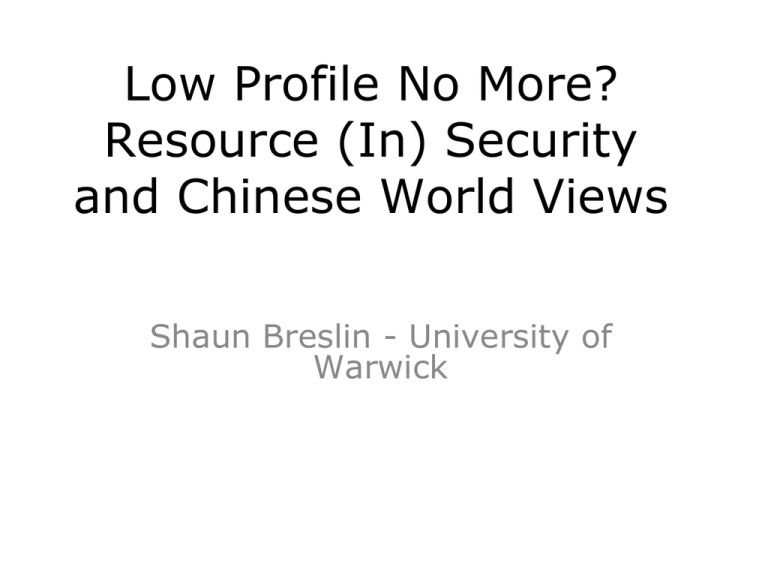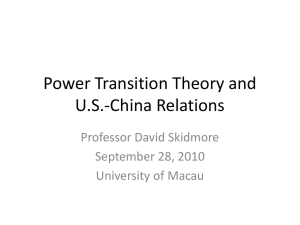Low Profile No More? Resource (In) Security and Chinese World Views
advertisement

Low Profile No More? Resource (In) Security and Chinese World Views Shaun Breslin - University of Warwick 韬光养晦 Hide brightness and nourish obscurity Hide capabilities, bide our time and accomplish some things Xiong Guangkai – deliberately mis-translated by people with a Cold War mentality Countering or reinforcing the “China Threat Thesis”? Who Speaks for China? Yang Jiechi on the China Dream “Comrade Xi Jinping's comprehensive, profound and exquisite description of the Chinese dream” “Developing a G2 relationship without abandoning the rest of the world” equality, justice and mutual benefit “The Great renewal of the Chinese nation” “a continuation and development of the important thinking of China's peaceful development” “attempts by certain international forces at distorting and smearing the Chinese dream” Investment Projects blocked through security concerns 2005 China National Offshore Oil Corporation and Unocal 2008 Huawei and 3Com 2009 China Northwest Nonferrous International Investment Company and Firstgold 2010 Anshan Iron and Steel Group and the Steel Development Company 2012 Huawei again in Aistralia Development of overseas resource development plan in 2001 Around 180 projects in 37 different countries State Owned National oil company is dominant actor acquired UK, Russian and Canadian companies including “hostile” take-overs Export-Import bank acts as state credit agency to support overseas investments Active energy diplomacy by the President – 11 MOUS with energy producing countries. Particularly keen to benefit from changed political situation in Iraq Expansion into land leases and purchases even leading to a coup in Madagascar in 2009 China, Resources and not quite yet the End of “The End of History”? Barma and Ratner 2006 “[China] could set scores of developing nations away from the path of liberal democracy, creating a community of countries that reject Western views of human rights and accepted standards of national governance” •undermine the liberal West’s attempts to use sanctions to promote political change in “rogue states” like the Sudan, Burma and Zimbabwe •bolster authoritarian regimes that the West is trying to persuade to move towards more democratic political systems •undermine attempts to encourage the promotion of Human Rights and more tolerant political cultures in existing (imperfect) democracies •encourage existing democratic governments to move towards more authoritarian forms of politics •bolster socialist/proto-socialist democratic governments – some of whom are hostile to the interests of the West/US •undermine the promotion of (neo)liberal economic paradigms and reinforces the appeal of strong state External Conceptions of China’s Global (Energy) Role China and the price and distribution of global resources China as new (and big) market player China as predatory market player state companies and national objectives China as system shaper? China and the global liberal order shoring up rogue states alternative partner alternative model? Changing patters of power and the global financial crisis Sea lanes and communications and controlling global supplies China’s territorial claims in South China Seas and elswhere Pak “oil (wars) in the pipleline?” Sources of supplies ? 1993 – major suppliers were Oman, Indonesia, Yemen and Angola (c70%) 2003 – Saudi Arabia, Iran, Angola, Oman, Yemen and Sudan (c75%) 2011 - Saudi Arabia (20%), Angola (12), Iran (11), Oman (7), Russia (7), Sudan (5), Iraq (5), Venezuela (4), Kazakhstan (3.5), Kuwait (3) Zha Daojiong - Self sufficiency and insecurity Phase One – neither sufficient nor secure, 1949-63 Phase Two – sufficient but insecure, 1963-mid 1970s Phase Three – declining self sufficiency, increasingly secure, mid-1970s-1993 oil imports start from Oman, 1983 net importer of oil, 1993 (petroleum, 1996) Phase Four – not sufficient not insecure, but getting concerned1993-2000ish Changing conceptions of security from geostrategic to geo-economic Oil demand increases Phase Five, not sufficient and growing concerns, 2000regime legitimacy and “dependence” on the capitalist global economy Changing conceptions of energy security sustainability of coal driven economy economically and environmentally 1999-2000, Brent US$10.44 per barrel to US$25.10 1999-2000, Chinese net oil imports from US$3,876mn to US$12,733 “old” security concerns in Africa and Middle East currency policy and the dollar “peg” China as a late comer into an existing energy economy Dominance of US and Western interests The Domestic Context Coal is still be far the most important source of energy 2009 – becomes net coal importer (but less than 10 per cent of total use) primarily due to quality and distribution bottlenecks Efficiency and usage energy per $ produced decreasing again after increasing as a consequence of post-crisis stimulus (a) still high(ish) in international comparison (b) varies greatly between places and types of activity Refining capacity and technical ability – need for “light and sweet” oil Nuclear power and clean power account for 1% and 8% of China's total power generation respectively the green agenda (and the decline of suntech) The distribution of power within China competitive provincial growth strategies and “irrational” resource utilisation exacerbated by response to the global crisis But “Going Global” is clearly important SOURCE: Center for American Progress at http://www.americanprogre ss.org/issues/2010/04/china _oil_map.html A state led project to dominate global energy supplies? BUT ….. New actors - local companies, private operators Role of Competition BETWEEN Chinese SOEs in overseas markets as well as increasingly at home Downs, Brautigam and others – companies take the lead and have operational autonomy Increased autonomy due to financial resources, globalised management, seeking advice and funds from global sources Many energy related projects do not have direct energy provision consequences for China commercial projects (often with state help) to make money with development consequences for the partner eg: Upgrading electricity generation in Malawi Mayer and Wubbeke overseas oil assets c.30% of net imports Jiang and Sinton for International Energy Agency c.36% in first half of 2010 But “most” (?) simply sold into global markets rather than going straight back to China “almost all the equity production Chinese NOCs have in the Americas was sold locally instead of being shipped back to China (FACTS Global Energy, 2010). Considering geographical distances, it is more costly to ship that oil to China. Additionally, Venezuelan heavy crude is not compatible with existing Chinese refining capacities.” Some Conclusions (1) Important to separate out different actors, interests and voices the geostrategic state project from other objectives (2) Towards a liberal energy peace? • US naval hegemony and stable oil supplies • the USA is the country with which China has launched the largest number of collaborative energy development programmes and projects • energy policy a key agenda item in bilateral dialogues – not just specific energy related fora (US-China Energy Policy Dialogue, the US-China Oil and Gas Industry Forum, the Peaceful Uses of Nuclear Technologies Agreement), but in broader areas of discussion as well (the US-China Economic Development and Reform Dialogue, the Joint Co-ordinating Committee on Science and Technology, and the US-China Strategic Economic Dialogue) • Need for imported oil (and oil that China can refined) requires a peaceful and stable international environment • China, economic interests, and intervention in Libya (3) But easily become politicised perceptions of insecurity remain strong Why is the US surrounding China ? East Asia as a bellwether for China as a global power (4) Wei Zonglei and Fu Yu China’s four different simultaneous identities (5) Chinese world view dissatisfied responsible great power






